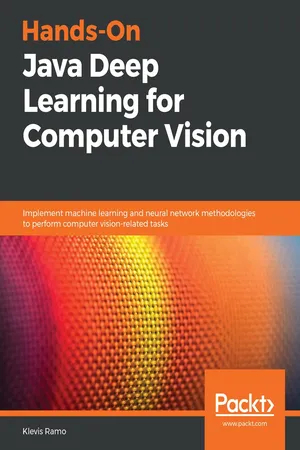
Hands-On Java Deep Learning for Computer Vision
Implement machine learning and neural network methodologies to perform computer vision-related tasks
Klevis Ramo
- 260 pages
- English
- ePUB (mobile friendly)
- Available on iOS & Android
Hands-On Java Deep Learning for Computer Vision
Implement machine learning and neural network methodologies to perform computer vision-related tasks
Klevis Ramo
About This Book
Leverage the power of Java and deep learning to build production-grade Computer Vision applications
Key Features
- Build real-world Computer Vision applications using the power of neural networks
- Implement image classification, object detection, and face recognition
- Know best practices on effectively building and deploying deep learning models in Java
Book Description
Although machine learning is an exciting world to explore, you may feel confused by all of its theoretical aspects. As a Java developer, you will be used to telling the computer exactly what to do, instead of being shown how data is generated; this causes many developers to struggle to adapt to machine learning.
The goal of this book is to walk you through the process of efficiently training machine learning and deep learning models for Computer Vision using the most up-to-date techniques. The book is designed to familiarize you with neural networks, enabling you to train them efficiently, customize existing state-of-the-art architectures, build real-world Java applications, and get great results in a short space of time. You will build real-world Computer Vision applications, ranging from a simple Java handwritten digit recognition model to real-time Java autonomous car driving systems and face recognition models.
By the end of this book, you will have mastered the best practices and modern techniques needed to build advanced Computer Vision Java applications and achieve production-grade accuracy.
What you will learn
- Discover neural networks and their applications in Computer Vision
- Explore the popular Java frameworks and libraries for deep learning
- Build deep neural networks in Java
- Implement an end-to-end image classification application in Java
- Perform real-time video object detection using deep learning
- Enhance performance and deploy applications for production
Who this book is for
This book is for data scientists, machine learning developers and deep learning practitioners with Java knowledge who want to implement machine learning and deep neural networks in the computer vision domain. You will need to have a basic knowledge of Java programming.
Frequently asked questions
Information
Introduction to Computer Vision and Training Neural Networks
- The computer vision state
- Exploring neural networks
- The learning methodology of neural networks
- Organizing data and applications
- Effective training techniques
- Optimizing algorithms
- Configuring the training parameters of the neural network
- Representing images and outputs
- Building a handwritten digit recognizer
The computer vision state
- Autonomous driving: An algorithm is able to detect the location of pedestrians and other cars, helping to make decisions about the direction of the vehicle and avoid accidents.
- Face recognition and smarter mobile applications: You may already have seen phones that can be unlocked using facial recognition. In the near future, we could have security systems based on this; for example, the door of your house may be unlocked by your face or your car may start after recognizing your face. Smart mobile applications with fancy features such as applying filters and grouping faces together have also improved drastically.
- Art generation: Even generating art will be possible, as we will see during this book, using computer vision techniques.
The importance of data in deep learning algorithms
Table of contents
- Title Page
- Copyright and Credits
- About Packt
- Contributor
- Preface
- Introduction to Computer Vision and Training Neural Networks
- Convolutional Neural Network Architectures
- Transfer Learning and Deep CNN Architectures
- Real-Time Object Detection
- Creating Art with Neural Style Transfer
- Face Recognition
- Other Books You May Enjoy